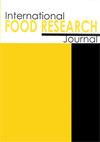Effectiveness of washing with atung (Parinarium glaberimum Hassk) solution on quantity and quality of dark meat yellowfin tuna (Thunnus albacares) surimi
IF 0.7
4区 农林科学
Q4 FOOD SCIENCE & TECHNOLOGY
引用次数: 0
Abstract
Yellowfin tuna (Thunnus albacares) is the world's second-largest commodity with good nutrition. After processing, some wastes / residues / by-products can be used to produce surimi which still retains the tuna meat properties. The manufacturing of surimi requires safe preservatives, such as the natural preservative, atung (Parinarium glaberimum Hassk), which contains antibacterial substances. Therefore, the present work aimed to determine the effectiveness of 4% (w/v) atung solution on the quantity and quality of yellowfin tuna surimi produced from tuna by-products. The fish meat was treated with a washing agent of ice water and 4% atung solution with several washing frequencies. The parameters assessed were the yield and quality of surimi by analysing the protein content, myofibrillar protein content (salt soluble), water-holding capacity, Salmonella spp., and E. coli. In addition, the parameters included teeth-cutting, ashi strength, and folding. The 4% (w/v) atung solution effectively produced tuna fish surimi with 68.50% yield, 20.62% protein, 8.87% myofibrillar protein, and free from Salmonella spp. and E. coli. The water-holding capacity of the surimi was recorded at 68.9% and increased to 73.3% after three washes. The use of 4% (b/v) atung solution effectively produced surimi with a teeth-cutting value of 7.80 - 7.92, and an ashi strength of 7.97 - 8.08, whereas the folding test was B to A (3.80) after four washes.用阿通(Parinarium glaberimum Hassk)溶液清洗对深色黄鳍金枪鱼鱼糜的数量和质量的影响
黄鳍金枪鱼(Thunnus albacares)是世界第二大商品,营养丰富。加工后的一些废料/残渣/副产品可用于生产鱼糜,但仍保留了金枪鱼肉的特性。鱼糜的生产需要安全的防腐剂,例如含有抗菌物质的天然防腐剂 Atung(Parinarium glaberimum Hassk)。因此,本研究旨在确定 4%(w/v)阿通溶液对利用金枪鱼副产品生产的黄鳍金枪鱼鱼糜的数量和质量的影响。使用冰水和 4% 阿通溶液作为清洗剂,以不同的清洗频率处理鱼肉。通过分析蛋白质含量、肌纤维蛋白含量(盐溶性)、持水能力、沙门氏菌属和大肠杆菌,评估了鱼糜的产量和质量。此外,参数还包括切齿度、韧度和折叠度。4%(w/v)的阿通溶液能有效地生产出金枪鱼鱼糜,产量为 68.50%,蛋白质含量为 20.62%,肌纤维蛋白质含量为 8.87%,不含沙门氏菌和大肠杆菌。鱼糜的持水量为 68.9%,经过三次水洗后增加到 73.3%。使用 4%(b/v)的阿通溶液能有效地生产出切牙值为 7.80 - 7.92、阿氏强度为 7.97 - 8.08 的鱼糜,而经过四次水洗后,折叠测试结果为 B 到 A(3.80)。
本文章由计算机程序翻译,如有差异,请以英文原文为准。
求助全文
约1分钟内获得全文
求助全文
来源期刊

international food research journal
Agricultural and Biological Sciences-Food Science
CiteScore
1.40
自引率
0.00%
发文量
75
期刊介绍:
The International Food Research Journal (IFRJ) publishes papers in English, six (6) issues a year with the coverage of:
Food Science and Technology
Nutrition and Dietetics
Agriculture, multidisciplinary
Chemistry, multidisciplinary
The scope of the Journal includes:
Food Science, Food Technology and Food Biotechnology
Product Development and Sensory Evaluation
Food Habits, Nutrition, and Health
Food Safety and Quality
Food Chemistry, Food Microbiology, Food Analysis and Testing
Food Engineering
Food Packaging
Food Waste Management
Food Entrepreneur
Food Regulatory
Post-Harvest Food Management
Food Supply Chain Management
Halal Food and Management
 求助内容:
求助内容: 应助结果提醒方式:
应助结果提醒方式:


